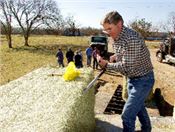Fall Forage Samples Showing Lower Protein; Ranchers Advised Against Relying On Previous Year’s Test Results

Robert Seay, former Benton County Extension staff chair, pulls a forage sample. 2009 file photo.
U of A System Division of Agriculture photo by Fred Miller
LITTLE ROCK, ARK.
Lab-tested forage samples are showing lower protein levels and Arkansas livestock producers will need to adjust their herd’s winter rations to compensate, said Shane Gadberry, professor-ruminant nutrition for the University of Arkansas System Division of Agriculture.
Agricultural Diagnostic Lab operated by the Division of Agriculture at Fayetteville offers a variety of services including forage testing. The lab looks at protein levels, as well as fiber, fat, moisture and a variety of other nutrients. The lab is part of the Arkansas Agricultural Experiment Station, the Division of Agriculture’s research arm.
“It wasn't long after hay harvest that county agents started noticing forage test samples were returning lower in protein for producers that routinely test hay,” Gadberry said. “We followed up these reports and worked with the Agricultural Diagnostics Lab to summarize test result trends.”
Trending lower
Gadberry said that “examining test results from 2014 through most of August 2019 confirmed what they were reporting. The median protein was approximately 2 percentage units lower and fiber 2 percentage units higher.”
“When we are short on protein, the rumen microbes aren't as efficient at digesting forages,” he said. “This causes cows to eat less hay which adds to the challenge of meeting cows’ nutrient needs.”
Protein and energy are critical, especially in winter, for cows with calves. Not only do the cows have to feed themselves, but also spend calories keeping warm and producing milk.
“We typically see about 40 percent of samples below the protein requirement for lactating cows, but the 2019 samples analyzed closer to 60 percent being below lactating cow requirement for protein,” Gadberry said. “We always run an energy deficit for lactating cows with close to 80 percent being inadequate in digestible energy.”
Some of the quality problem may stem from 2019’s very wet start.
Gadberry said he thinks “the very wet conditions early influenced the early hay crop. Producers had a difficult time getting into fields to fertilize and control weeds.
“We could also be looking at not just this year but also cumulative effects that include 2018 which was also a challenging year for managing hay fields,” he said. “Our hay producers should return to those fields and take soil samples to see if they need to adjust their fertilization practices this coming year.”
Feeding decisions
Gadberry said producers shouldn’t make supplemental feeding decisions based on the book values for forages, nor should they make those decisions based on the previous year’s forage test results.
“Forage testing is cheap compared to the consequence of cows losing too much body condition over winter because they weren't supplemented with the right type and amount of nutrients,” he said. “Our county extension agents are trained to use ration balancing tools, so producers that submit samples through their county extension office can also get assistance with evaluating supplemental feed options.” ∆